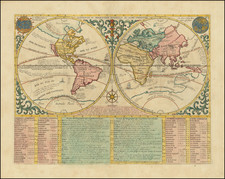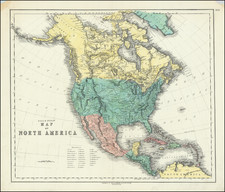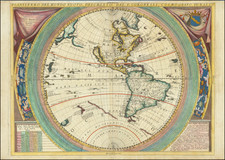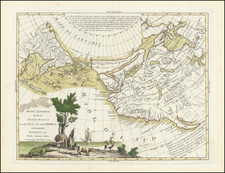An English Rarity -- Sea of Carolina Virginia Mary-Land New York New England New Scotland
Rare 2-sheet map of North America, published by William Berry in London in 1681.
William Berry and Robert Morden petitioned the King of England for a license to publish maps for a world atlas in 1678. By 1680, William Berry, then working alone, had completed a 2-sheet map of the World. The present map also bears the date of 1680 in the scale of miles, but was almost certainly not completed until 1681, as it includes a references to Pennsylvania, which was not granted its charter until March 4, 1681. As such, it may in fact pre-date Thornton & Seller's A Map of Some of the South and eastbounds of Pennsylvania in America . . . , which is generally regarded as the first printed map to name Pennsylvania, which was not printed until the Summer of 1681.
Burden notes that as a prominent mapmaker, Berry "would have undoubtedly been approached [by William Penn], especially if given the opportunity to influence the outcome of a late yet to be finished." Curiously the name Pennsylvania does not appear in the title at the top (which names many other colonies), there is no engraved boundary line between Pennsylvania and New York and there is evidence of erasures on the plate. As such, all indications are that it was a last minute addition to a plate that was begun in 1680, but likely not completed until 1861. All of the above suggests that the map was released by Berry very shortly after Penn's establishment of the colony.
The map is largely based upon Alexis Hubert Jaillot's map of 1674, although the names have been significantly anglicized and ther are other additions and corrections. Burden also suggests that this fine map could have been engraved be Herman Moll, making it among the earliest examples of his work. The map includes a very large representation of California as and Island and a bold depiction of the Straits of Anian.
Rarity
All William Berry maps are extremely rare.
This is the second example we have had in in over 30 years (1992-2023).
The popular misconception of California as an island can be found on European maps from the sixteenth through the eighteenth centuries. From its first portrayal on a printed map by Diego Gutiérrez, in 1562, California was shown as part of North America by mapmakers, including Gerardus Mercator and Abraham Ortelius. In the 1620s, however, it began to appear as an island in several sources. While most of these show the equivalent of the modern state of California separated from the continent, others, like a manuscript chart by Joao Teixeira Albernaz I (ca. 1632) now in the collection of the National Library of Brasil shows the entire western half of North Americas as an island.
The myth of California as an island was most likely the result of the travel account of Sebastian Vizcaino, who had been sent north up the shore of California in 1602. A Carmelite friar, Fray Antonio de la Ascensión, accompanied him. Ascension described the land as an island and around 1620 sketched maps to that effect. Normally, this information would have been reviewed and locked in the Spanish repository, the Casa de la Contratación. However, the manuscript maps were intercepted in the Atlantic by the Dutch, who took them to Amsterdam where they began to circulate. Ascensión also published descriptions of the insular geography in Juan Torquemada’s Monarquia Indiana (1613) (with the island details curtailed somewhat) and in his own Relación breve of ca. 1620.
The first known maps to show California as an island were on the title pages of Antonio de Herrera’s Descripción de las Indias Occidentales (1622) and Jacob le Maire's Spieghel Der Australische Navigatie (1622). Two early examples of larger maps are those by Abraham Goos (1624) and another by Henry Briggs, which was included in Samuel Purchas’ Hakluytus Posthumus or Purchas his Pilgrimes (1625). In addition to Briggs and Goos, prominent practitioners like Jan Jansson and Nicolas Sanson adopted the new island and the practice became commonplace. John Speed’s map (1626-7), based on Briggs’ work, is well known for being one of the first to depict an insular California.
The island of California became a fixture on mid- and late-seventeenth century maps. The island suggested possible links to the Northwest Passage, with rivers in the North American interior supposedly connecting to the sea between California and the mainland. Furthermore, Francis Drake had landed in northern California on his circumnavigation (1577-80) and an insular California suggested that Spanish power in the area could be questioned.
Not everyone was convinced, however. Father Eusebio Kino, after extensive travels in what is now California, Arizona, and northern Mexico concluded that the island was actually a peninsula and published a map refuting the claim (Paris, 1705). Another skeptic was Guillaume De L’Isle. In 1700, De L’Isle discussed “whether California is an Island or a part of the continent” with J. D. Cassini; the letter was published in 1715. After reviewing all the literature available to him in Paris, De L’Isle concluded that the evidence supporting an insular California was not trustworthy. He also cited more recent explorations by the Jesuits (including Kino) that disproved the island theory. Later, in his map of 1722 (Carte d’Amerique dressee pour l’usage du Roy), De L’Isle would abandon the island theory entirely.
Despite Kino’s and De L’Isle’s work, California as an island remained common on maps until the mid-eighteenth century. De L’Isle’s son-in-law, Philippe Buache, for example, remained an adherent of the island depiction for some time. Another believer was Herman Moll, who reported that California was unequivocally an island, for he had had sailors in his offices that claimed to have circumnavigated it. In the face of such skepticism, the King of Spain, Ferdinand VII, had to issue a decree in 1747 proclaiming California to be a peninsula connected to North America; the geographic chimera, no matter how appealing, was not to be suffered any longer, although a few final maps were printed with the lingering island.












![[Educational Map] North America](https://storage.googleapis.com/raremaps/img/small/68773.jpg)

![[French America and the Triangular Trade] L'Amérique Françoise Où son Décrites La France Nouvelle, La France Insulaire, La France Equinoctiale, et autre pais Par P. Du Val d'Abbeville Geographe du Roy . . .](https://storage.googleapis.com/raremaps/img/small/91968.jpg)